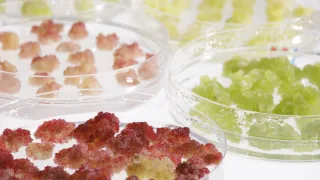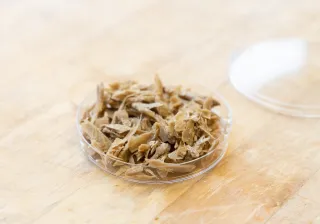VTT Technical Research Centre of Finland is developing a new and promising method of producing healthy and tasty plant-based food through plant cell culture (PCC) technology rather than field cultivation. The development work was elevated to a whole new level by a study on the nutritional properties of PCCs grown from cloudberry, lingonberry and stoneberry. Their nutritional value was proven to be much higher than anticipated, in addition to having a nice sensory profile.
In recent years, VTT has developed plant cell culture technologies with the aim of creating a completely new and groundbreaking method of producing vegetable foodstuffs and ingredients. As shown by the results of the study published in an article in the food science and technology journal Food Research International in February 2018, the production method developed at VTT is looking more promising than ever.
Population growth and food demands
"This is not only a completely new opportunity for the food industry but to society as a whole. There is not enough arable land to meet the growing global population's food demands; new solutions are desperately needed. Cell cultures have serious potential for meeting this need," says Emilia Nordlund, Leader of VTT's Food Solutions Team.
Cell culture production of meat has been a popular topic in public discussion. In the future, however, PCCs can be used to produce food that has higher nutritional value in a considerably faster and easier way and at lower costs.
Nutritional and sensory properties
The objective of VTT's study was to examine the nutritional and sensory properties of dried and fresh cells grown from cloudberry, lingonberry and stoneberry by using PCC technology.
The PCC samples had a pleasant, fresh and mild flavour, which resembled that of corresponding fresh fruits. The berry-like flavour was more intense in the dried samples, which were also melting appealingly in mouth. The visual appearance of cell cultures also resembled that of the corresponding fresh fruits.
The plant cells were proven to be nutritionally valuable – in most respects even more so than fruits. The PCC samples had high protein content of 14-19%, and in vitro analysis showed good protein digestibility. The contents of essential amino acids important to muscle, bone and tissue health were higher than those reported for soy, which is considered an excellent source of amino acids. The dietary fibre of the samples varied between 21 and 37%, which is clearly more than in breakfast cereals, for example. Energy content was also higher than anticipated. The PCC samples were also found to be rich sources of unsaturated fatty acids. A previous study of VTT has shown that cell cultures have high contents of polyphenols that are known for their health-promoting effects (Ref. Planta, 2017).
Limitless variations
"Biomass produced with plant cell culture technology should be considered as completely new food material, which is why their characteristics should not necessarily be compared with corresponding fresh fruits. Their excellent nutritional properties are a sign of great future potential of plant cell cultures in creating new types of superfoods. The variations produced by using different plants offer limitless possibilities," says Heiko Rischer, Leader of VTT's Plant Biotechnology Research Team.
For the food industry, plant cells and their dried versions offer opportunities to create new types of healthy food products and ingredients, such as smoothies, caviar-like compotes and snack foods. The key thing to remember in product development and from the logistics point of view is that all materials are always at their best when they are fresh. However, only the sky seems to be the limit when exploring new product innovations with the cell materials.
For example, in the "Food My Way" project, VTT's scientists are currently coming up with ideas for future food vending machines that enable consumers to buy healthy food products tailored to their personal tastes. An appliance designed for use in a café or restaurant could include a bioreactor for growing a fresh cell compote to be added to a food product.
In addition to further research on the subject with new cell lines and food design, the market entry of PCCs requires regulatory approval as a novel food.
VTT is actively developing the concept further in the frame of the strategic Food 4.0 vision and invites parties interested in developing new plant materials, the related production processes and equipment to collaborate.
References:
Emilia Nordlund, Martina Lille, Pia Silventoinen, Heli Nygren, Tuulikki Seppänen-Laakso, Atte Mikkelson, Anna-Marja Aura, Raija-Liisa Heiniö, Liisa Nohynek, Riitta Puupponen-Pimiä, Heiko Rischer. Plant cells as food – A concept taking shape. Food Research International 107 (2018), pp. 297-305. https://www.sciencedirect.com/science/article/pii/S0963996918301388
Jussi Suvanto, Liisa Nohynek, Tuulikki Seppänen-Laakso, Heiko Rischer, Juha-Pekka Salminen, Riitta Puupponen-Pimiä. Variability in the production of tannins and other polyphenols in cell cultures of 12 Nordic plant species. Planta, 246 (2017), pp 227-241. https://link.springer.com/article/10.1007%2Fs00425-017-2686-8





